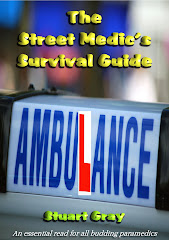Day shift: Nine calls; five by ambulance; four by car.
Stats: 3 abdo pains; 1 alcoholic fit; 2 head injuries; 1 unwell; 1 allergic reaction; 1 ?TIA.
I don’t want to say it’s typical... but it is. Abdominal pains at work – very common, especially in the low-paid services sector. So it didn’t surprise me that an employee of a posh club in the West End had done nothing about her tummy ache and vomiting, even though it had started last night and persisted until this morning. I wasn’t shocked that the 26 year-old had, instead of calling in and saying she was ill, wandered into work despite her discomfort and I didn’t feel any emotion about the fact that, although it didn’t merit one last night, an ambulance was now required to take her to hospital because now, suddenly, it was deemed an emergency.
She got me and the car.
The next abdominal pain was at home and I had no contact with the 63 year-old man complaining of it because a crew arrive with me and I left them to it.
Abdo pain number three was being attended to by a cycle unit but he thought I’d be best suited to transport the 22 year-old man from his place of work to a place of treatment (i.e hospital). Again, the patient had no medical history whatsoever and the pain had been going on for some time but he still went to work with it and took nothing to relieve it. Again, he wasn’t vomiting and again he was perfectly capable of walking to his GP or up to A&E with it. Alas, again, the emergency services were drafted in.
At a police station a 25 year-old man sat in his cell, shaking and vomiting into polystyrene cups (as you do). He was an alcoholic and his overnight stay had produced a reasonably predictable affect on him – he was going to have a fit. The custody nurse called an ambulance for him and I was sent to check on him. He had his seizure while I was there and it lasted about 2 minutes, after which, and during his post ictal confused state, he tried to throw one of the cups full of vomit and phlegm over me – luckily he grabbed the only empty cup on the floor. To me it was like a Lottery win.
Large Department Stores are going to call ambulances for most injuries, regardless of how minor they may seem because they want to feel that they’ve covered themselves. So, I was off to a very minor scalp wound, which couldn’t even be bothered to bleed properly, after a 28 year-old woman had the misfortune of receiving a glass picture frame on her head from a height of about two feet when it fell from a shelf she was perusing. The frame shattered on impact but she wasn’t knocked out and had been lucky that the height and speed of the falling item wasn’t greater (weight of object, approx 2kg - speed, approx 2kph, therefore energy received = 4 units). Still, she had to have her scalp looked at and I took her to the nearest A&E waiting area.
‘Generally unwell’ tends to mean many things to us and this is the term we’ll apply to things such as food poisoning, where the symptoms are there but the evidence is lacking. Thus, the 29 year-old woman who had been vomiting, had diarrhoea, fainted twice and now had abdominal pain, was given this relative term for my report. She was in bed in her hotel room, husband on scene, and was confused about her condition because every time she thought she was finally over it, she’d throw up or faint again. She’d been out and about on various trips around London but had come back to the safety of the Hotel room to call an ambulance. She’d had pasta in the Hotel restaurant the night before and I know that the management of these places get nervous about the possibility of a link between their food and a sick guest, so as soon as I was shown in (via the back door), the two managers scooted away, lest they overhear something undesirable.
An ambulance arrived for this patient, even though she could really have travelled for two minutes in the car to hospital.
An allergic reaction, consisting of a widespread urticarial rash and itching next and the 24 year-old woman was at work when it started. She’d had a veggie burger and thought that may have been the cause of it. Normally she is allergic to a few things, including chocolate, so she has these events every now and then but it had been years since the last one and this reaction was more intense. I took her and her work colleague in the car and she spent the duration of the trip scratching her legs like mad. It made me start to feel itchy as I drove along. Ironically, she was the first Muslim woman I’ve met who was born on Christmas day. I asked if she got extra presents. I know of at least one Jewish person who gets presents on that day!
It seems that for every call I’ve had where I’ve conveyed by car, the next call goes by ambulance, so I wasn’t surprised when the crew showed up for the 50 year-old lady who fell on the underground escalator and bumped her head. I was already walking her up the steps towards the car when they appeared. I could have saved an ambulance on this one but in the end it was probably for the best. An off-duty doctor, a medical student, two members of staff and myriad other people were around her when I got to the bottom of the escalator steps, so I wasn’t sure who was who. I identified the doc and the student and at least one lady who knew her. The fallen woman was weepy and vague; a bit slow to respond at times but I think this was mostly emotional. She was taking anti-depressants and it’s a question I will ask automatically for certain types of behaviour, so that I can rule out the injury as a cause, if not for certain, then as a probability.
On the way up, with the woman tucked inside a chair and the crew attending to her (she had a large closed bump on her head), I asked the lady who’d been holding her and calming her down a question.
‘How well do you know her then?’
‘Who? My mother?’
Oops.
I thought I was getting home on time but a last minute call came in and I was asked to go to a train station for a ‘man collapsed on train’. The 71 year-old may or may not have been cardiac arrest, such was the confusion caused by the limited information being supplied by those ‘on the ground’ as it were.
When I arrived, it took a few minutes to get to him because he was still on the train and it was at the opposite end of the station. Staff members were on hand to help and I found him on the floor, seemingly unconscious but breathing and with a pulse. He had wet himself and this was my first indication for a possible medical event. He’d open his eyes when I spoke to him but then gone right back to sleep. His friend was with him and he told me he’d just ‘dropped off’ during the train journey and had been like this for over an hour now. The man didn’t know where he was or what was going on and several attempts to communicate with him failed.
A crew was sent but they took a while to get to me and when they arrived, one of them had to go back to the ambulance for the trolley bed and then drive to the extreme end of the station to use the only lift that would accommodate it. This delayed the patient transfer by at least 20 minutes and if, as I suspected, the man was having a stroke, time was not on our side.
On oxygen, the patient became more lucid as we waited and began to understand a few things; who his friend was, where he was, etc. He wasn’t yet fully recovered but he seemed to have no physical deficit and so I now thought he had probably had a TIA. This did not take him out of the woods, however, so I really needed to have him on the ambulance and on his way to hospital as soon as possible but fate and the inadequate planning of the station’s management were to slow things down even more. I was now off-duty as far as the clock was concerned but still on that train with the patient on the floor.
Eventually the trolley bed was brought up and we got the patient onto it. He was now able to stand up and follow simple commands – we got him to the lift with all our equipment and staff in tow but now there was another problem. The lift doors wouldn’t open and we had to wait for a manager (apparently only one holds the key) to get to the lower floor and access it. Another 20 minutes slipped by as we waited and then lost patience. I decided we’d go to the other end of the station and try the smaller lift – the one they’d told us we couldn’t fit into.
After a 200 metre walk, with a trolley-bound, fully-recovered patient, his friend, two staff members and all our gear, we reached the other lift and squeezed in, whether it liked it or not. Once we’d got down to the ground floor, I had to drive one of the ambulance crew to the other side of the station, drop him off at his vehicle, then escort him back round to where the patient was waiting for us. Then we finally got him into the ambulance, did our obs and ECG and ‘blued’ him into hospital. The blue call seemed very moot and pointless after an hour messing around at that station but it had to be done.
The man arrived at hospital looking like nothing had ever happened to him. He’d reported headaches for the past week and if he’d just had a TIA and recovered, it meant he was possibly heading for a full-blown CVA, so we still did the best for him as far as I’m concerned but it was like Keystone ambulances and we all felt let down by the train station management – there was no plan for emergency patients; no exit route, no access for trolley beds and then no escape when we needed to get going. If we’d been resuscitating this patient, the situation would have been intolerable. I guarantee you they have an excellent fire plan though.
I went home grumpy an hour and a half later.
Be safe.
Subscribe to:
Post Comments (Atom)















1 comment:
Re; man on train. I agree that the emergency plan at that station sound a bit 'sub-prime' , but wonder if might have been quicker to leave him in-situ, and let the train convey him to a more suitable station?
Post a Comment